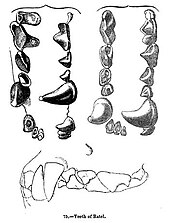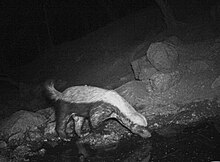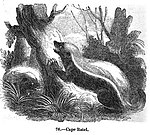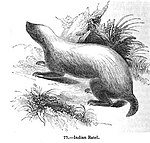Which Animal Is The Honey Badger Afraid To Attack
| Love badger Temporal range: middle Pliocene – Recent | |
|---|---|
 | |
| Conservation condition | |
| | |
| Scientific classification | |
| Kingdom: | Animalia |
| Phylum: | Chordata |
| Class: | Mammalia |
| Gild: | Carnivora |
| Family: | Mustelidae |
| Subfamily: | Mellivorinae |
| Genus: | Mellivora |
| Species: | Chiliad. capensis |
| Binomial proper noun | |
| Mellivora capensis (Schreber, 1776) | |
 | |
| Distribution | |
The honey badger (Mellivora capensis), besides known as the ratel ( or ), is a mammal widely distributed in Africa, Southwest Asia, and the Indian subcontinent. Because of its broad range and occurrence in a variety of habitats, it is listed as To the lowest degree Business organization on the IUCN Red List.
Information technology is the only living species in the genus Mellivora and in the mustelid subfamily Mellivorinae. Despite its name, the honey annoy does not closely resemble other badger species; instead, it bears more anatomical similarities to weasels. It is primarily a carnivorous species and has few natural predators considering of its thick skin, strength and ferocious defensive abilities.
Taxonomy

Viverra capensis was the scientific name used by Johann Christian Daniel von Schreber in 1777 who described a beloved badger skin from the Cape of Good Hope.[2] Mellivorae was proposed as name for the genus past Gottlieb Conrad Christian Storr in 1780.[3] Mellivorina was proposed every bit a tribe name by John Edward Gray in 1865.[4]
The honey badger is the only species of the genus Mellivora. Although in the 1860s it was assigned to the badger subfamily, the Melinae, it is now mostly agreed that it bears few similarities to the Melinae. It is much more closely related to the marten subfamily, Guloninae, and furthermore is assigned its ain subfamily, Mellivorinae.[v] Differences between Mellivorinae and Guloninae include differences in their dentition formulae. Though non in the same subfamily as the wolverines, which are a genus of large-sized and atypical Guloninae, the honey badger tin be regarded equally some other, analogous, form of outsized weasel or polecat.
Evolution
The species offset appeared during the middle Pliocene in Asia.[6] A number of extinct relatives are known dating back at least vii million years to the Late Miocene. These include Mellivora benfieldi from Due south Africa and Italy, Promellivora from Pakistan, and Howellictis from Chad. More afar relatives include Eomellivora, which evolved into several different species in both the Onetime and New Globe, and the giant, long-legged Ekorus from Kenya.[7]
Subspecies
In the 19th and 20th centuries, 16 zoological specimens of the honey annoy were described and proposed as subspecies.[8] Every bit of 2005[update], 12 subspecies are recognised as valid taxa.[9] Points taken into consideration in assigning different subspecies include size and the extent of whiteness or greyness on the dorsum.[x]
| Subspecies and dominance | Description | Range | Synonyms |
|---|---|---|---|
| Cape ratel (One thousand. c. capensis) (Schreber, 1776) | South and southwestern Africa | mellivorus (Cuvier, 1798) ratel (Sparrman, 1777) | |
| Indian ratel (M. c. indica) (Kerr, 1792) | Distinguished from capensis by its smaller size, paler fur and having a less distinct lateral white band separating the upper white and lower black areas of the body[11] | Western Center Asia northward to the Ustyurt Plateau and due east to Amu Darya. Outside the former Soviet Union, its range includes Afghanistan, Iran (except the southwestern part), western Islamic republic of pakistan and western Republic of india | mellivorus (Bennett, 1830) ratel (Horsfield, 1851) |
| Nepalese ratel (M. c. inaurita) (Hodgson, 1836) | Distinguished from indica by its longer, much woollier coat and having overgrown pilus on its heels[12] | Nepal and face-to-face areas e of it | |
| White-backed ratel (M. c. leuconota) (Sclater, 1867) | The entire upper side from the face to half-way along the tail is pure flossy white with little admixture of black hairs[13] | West Africa, southern Morocco, former French Congo | |
| Black ratel (M. c. cottoni) (Lydekker, 1906) | The fur is typically entirely blackness, with thin and harsh hairs.[xiii] | Ghana, northeastern Congo | sagulata (Hollister, 1910) |
| Lake Chad ratel (M. c. concisa) (Thomas and Wroughton, 1907) | The glaze on the back consists largely of very long, pure white bristle-hairs amongst long, fine, black underfur. Its distinguishing feature from other subspecies is the lack of the usual white bristle-hairs in the lumbar area[thirteen] | Sahel and Sudan zones, as far equally Somaliland | brockmani (Wroughton and Cheesman, 1920) buchanani (Thomas, 1925) |
| Speckled ratel (M. c. signata) (Pocock, 1909) | Although its pelage is the normal dense white over the crown, this pale color starts to thin out over the neck and shoulders, continuing to the rump where it fades into black. It possesses an extra lower molar on the left side of the jaw[13] | Sierra Leone | |
| Ethiopian ratel (M. c. abyssinica) (Hollister, 1910) | Ethiopia | ||
| Farsi ratel (M. c. wilsoni) (Cheesman, 1920) | Southwestern Iran and Iraq | ||
| Kenyan ratel (M. c. maxwelli) (Thomas, 1923) | Republic of kenya | ||
| Arabian ratel (M. c. pumilio) Pocock, 1946[14] | Hadhramaut, southern Arabia | ||
| Turkmenian ratel (M. c. buechneri) Baryshnikov, 2000 | Similar to the subspecies indica and inaurita, just is distinguished past its larger size and narrower postorbital constriction[fifteen] | Turkmenistan |
Description

Skull, as illustrated past Due north. N. Kondakov
The honey badger has a fairly long body, only is distinctly thick-set and broad beyond the back. Its skin is remarkably loose, and allows the beast to plough and twist freely within it.[16] The skin around the cervix is 6 millimetres (0.24 in) thick, an adaptation to fighting conspecifics.[17] The head is small and flat, with a brusk muzzle. The eyes are minor, and the ears are lilliputian more than ridges on the skin,[16] some other possible adaptation to avoiding damage while fighting.[17]
The honey badger has brusque and sturdy legs, with 5 toes on each foot. The anxiety are armed with very potent claws, which are short on the hind legs and remarkably long on the forelimbs. It is a partially plantigrade animal whose soles are thickly padded and naked up to the wrists. The tail is short and is covered in long hairs, relieve for below the base of operations.
Beloved badgers are the largest terrestrial mustelids in Africa. Adults measure 23 to 28 cm (9.i to 11.0 in) in shoulder height and 55–77 cm (22–30 in) in body length, with the tail adding another 12–thirty cm (4.vii–11.eight in). Females are smaller than males.[16] [xviii] In Africa, males weigh nine to xvi kg (xx to 35 lb) while females counterbalance 5 to 10 kg (eleven to 22 lb) on boilerplate. The mean weight of adult honey badgers from different areas has been reported at anywhere betwixt 6.4 to 12 kg (14 to 26 lb), with a median of roughly 9 kg (20 lb), per various studies. This positions it every bit the tertiary largest known badger, after the European badger and hog badger, and fourth largest extant terrestrial mustelid after additionally the wolverine.[viii] [19] [twenty] [21] [22] However, the boilerplate weight of 3 wild females from Iraq was reported every bit 18 kg (40 lb), about the typical weight of male wolverines or male person European badgers in late autumn, indicating that they can attain much larger than typical sizes in favorable weather.[23] [24] However, an woman and two males in India were relatively small, at the respective weights of six.four kg (14 lb) and a median of eight.iv kg (19 lb).[eight] Skull length is 13.9–14.5 cm (5.five–5.vii in) in males and 13 cm (5.ane in) for females.[25] [26]
In that location are two pairs of mammae.[27] The honey badger possesses an anal pouch which, unusual amidst mustelids, is eversible,[28] a trait shared with hyenas and mongooses. The smell of the pouch is reportedly "suffocating", and may help in calming bees when raiding beehives.[29]
The skull bears picayune similarity to that of the European badger, and profoundly resembles a larger version of that of a marbled polecat.[30] The skull is very solidly built, with that of adults having no trace of an contained bone construction. The braincase is broader than that of dogs.

The dental formula is: 3.1.3.1 3.1.iii.1 . The teeth oft display signs of irregular development, with some teeth being exceptionally pocket-size, gear up at unusual angles or absent altogether. Dear badgers of the subspecies signata have a second lower molar on the left side of their jaws, but not the correct. Although it feeds predominantly on soft foods, the love badger's cheek teeth are often extensively worn. The canine teeth are exceptionally short for carnivores.[31] The natural language has sharp, backward-pointing papillae which assistance it in processing tough foods.[32]
The winter fur is long, (being 40–50 mm (1.6–ii.0 in) long on the lower back), and consists of sparse, fibroid, bristle-like hairs, with minimal underfur. Hairs are even sparser on the flanks, belly and groin. The summertime fur is shorter (being only 15 mm (0.59 in) long on the dorsum) and even sparser, with the abdomen being one-half blank. The sides of the caput and lower trunk are pure black. A large white band covers the upper torso, from the meridian of the head to the base of the tail.[33] Beloved badgers of the cottoni subspecies are unique in being completely blackness.[13]
Behaviour and ecology

The honey annoy is mostly solitary, but has also been sighted in Africa to hunt in pairs during the breeding flavour in May. Information technology also uses one-time burrows of aardvark, warthog and termite mounds.[32] It is a skilled digger, able to dig tunnels into hard ground in 10 minutes. These burrows ordinarily take only one entry, are unremarkably only 1–3 thousand (three.3–9.8 ft) long with a nesting sleeping accommodation that is non lined with any bedding.[34]
The honey badger is notorious for its force, ferocity and toughness. It is known to savagely and fearlessly attack nigh any other species when escape is impossible, reportedly even repelling much larger predators such as lion and hyena.[35] Bee stings, porcupine quills, and beast bites rarely penetrate their skin. If horses, cattle, or Cape buffalos intrude upon a beloved badger'due south burrow, it will attack them.[31] In Kalahari Gemsbok National Park, a honey annoy was killed by a lion.[36] [37] In the Cape Province it is a potential prey species of the African leopard.[38] [39] African rock pythons,[viii] [40] Nile crocodiles and spotted hyenas also casualty on dear badgers occasionally.[ citation needed ]
Diet

Indian honey badger drinks from a natural stream
The honey badger has the least specialised diet of the weasel family next to the wolverine.[17] It accesses a big part of its food past digging it out of burrows.[8] It often raids beehives in search of both bee larvae and dearest.[41] Information technology also feeds on insects, frogs, tortoises, turtles, lizards, rodents, snakes, birds and eggs. It also eats berries, roots and bulbs.[8] When foraging for vegetables, it lifts stones or tears bark from trees. Some individuals accept even been observed to hunt abroad panthera leo cubs from kills.[32] It devours all parts of its prey, including skin, pilus, feathers, flesh and bones, belongings its nutrient downwardly with its forepaws.[42] Information technology feeds on a wide range of vertebrates and seems to subsist primarily on small vertebrates. Honey badgers studied in Kgalagadi Transfrontier Park preyed largely on geckos and skinks (47.9% of prey species), gerbils and mice (39.7% of casualty). The bulk of its prey comprised species weighing more 100 g (3.5 oz) such equally cobras, young African rock python and South African springhare.[43] In the Kalahari, honey badgers were as well observed to assault domestic sheep and goats, too as kill and eat blackness mambas.[forty] [44] A honey badger was suspected to accept cleaved up the shells of tent tortoises in the Nama Karoo.[45] In India, honey badgers are said to dig upwardly homo corpses.[46]
Despite pop conventionalities, at that place is no evidence that honeyguides guide the dearest badger.[47]
Reproduction
Little is known of the honey badger's breeding habits. Its gestation period is thought to last half dozen months, usually resulting in two cubs, which are born blind. Its lifespan in the wild is unknown, though captive individuals have been known to live for approximately 24 years.[10] The voice of the love annoy is a hoarse "khrya-ya-ya-ya" sound. When mating, males emit loud grunting sounds.[48] Cubs vocalise through plaintive whines.[ten] When confronting dogs, honey badgers scream like bear cubs.[49]
Distribution and habitat

Beloved badger in the Jerusalem Biblical Zoo
The love badger ranges through about of sub-Saharan Africa, from the Western Cape, South Africa, to southern Morocco and southwestern People's democratic republic of algeria and outside Africa through Arabia, Iran, and Western asia to Turkmenistan and the Indian Peninsula. It is known to range from sea level to as much as 2,600 one thousand (8,500 ft) in a higher place sea level in the Moroccan Loftier Atlas and 4,000 grand (13,000 ft) in Ethiopia's Bale Mountains.[1]
Relationships with humans
Dear badgers ofttimes become serious poultry predators. Because of their strength and persistence, they are hard to deter. They are known to rip thick planks from hen-houses or burrow underneath stone foundations. Surplus killing is mutual during these events, with one incident resulting in the death of 17 Muscovy ducks and 36 chickens.[32]
Because of the toughness and looseness of their skin, honey badgers are very hard to impale with dogs. Their peel is hard to penetrate, and its looseness allows them to twist and turn on their attackers when held. The simply safe grip on a beloved badger is on the back of the neck. The skin is also tough plenty to resist several machete blows. The only sure mode of killing them quickly is through a blow to the skull with a club or a shot to the head with a gun, as their skin is almost impervious to arrows and spears.[l]
During the British occupation of Basra in 2007, rumours of "homo-eating badgers" emerged from the local population, including allegations that these beasts were released by the British troops, something that the British categorically denied.[51] [52] A British army spokesperson said that the badgers were "native to the region but rare in Iraq" and "are unremarkably only dangerous to humans if provoked".[53] The managing director of Basra's veterinary hospital, Mushtaq Abdul-Mahdi, confirmed that honey badgers had been seen in the surface area as early on as 1986. The deputy dean of Basra'southward veterinarian college, Ghazi Yaqub Azzam, speculated that "the badgers were existence driven towards the city because of flooding in marshland north of Basra."[52] The effect received coverage in the Western press during the 2007 giddy season.[54]
The honey annoy has also been reported to dig up human corpses in Bharat.[55] In Kenya, the honey badger is a major reservoir of rabies[56] [57] and is suspected to be a significant contributor to the sylvatic cycle of the affliction.[58]
Notes
- ^ a b Exercise Linh San, Due east.; Begg, C.; Begg, K. & Abramov, A.5. (2016). "Mellivora capensis". IUCN Ruddy List of Threatened Species. 2016: e.T41629A45210107. doi:x.2305/IUCN.United kingdom.2016-i.RLTS.T41629A45210107.en . Retrieved 19 November 2021.
- ^ Schreber, J. C. D. (1777). "Das Stinkbinksen". Die Säugethiere in Abbildungen nach der Natur mit Beschreibungen. Erlangen: Wolfgang Walther. pp. 450–451.
- ^ Storr, G. C. C. (1780). "Mellivorae". Prodromus methodi mammalium. Tübingen: Reiss. p. 34.
- ^ Grey, J. E. (1865). "Revision of the genera and species of Mustelidae contained in the British Museum". Proceedings of the Zoological Society of London: 100–154.
- ^ Koepfli KP, Deere KA, Slater GJ, et al. (2008). "Multigene phylogeny of the Mustelidae: Resolving relationships, tempo and biogeographic history of a mammalian adaptive radiation". BMC Biol. 6: 4–5. doi:ten.1186/1741-7007-half dozen-x. PMC2276185. PMID 18275614.
- ^ Heptner & Sludskii 2002, pp. 1209–1210
- ^ Valenciano, A.; Govender, R. (July 2020). "New fossils of Mellivora benfieldi (Mammalia, Carnivora, Mustelidae) from Langebaanweg, 'East' Quarry (South Africa, Early on Pliocene) : re-evaluation of the African Neogene Mellivorines". Journal of Vertebrate Paleontology. xl (4): e1817754. doi:x.1080/02724634.2020.1817754. S2CID 227249176.
- ^ a b c d e f Vanderhaar, J. M. & Yeen Ten Hwang (2003). "Mellivora capensis" (PDF). Mammalian Species (721): ane–eight. doi:10.1644/0.721.one.
- ^ Wozencraft, West. C. (2005). "Species Mellivora capensis". In Wilson, D. E.; Reeder, D. Yard. (eds.). Mammal Species of the Earth: A Taxonomic and Geographic Reference (3rd ed.). Johns Hopkins Academy Press. p. 612. ISBN978-0-8018-8221-0. OCLC 62265494.
- ^ a b c Rosevear 1974, p. 123
- ^ Pocock 1941, p. 458
- ^ Pocock 1941, p. 462
- ^ a b c d east Rosevear 1974, pp. 126–127
- ^ Pocock, I. R. (1946). "External and cranial characters of some rare Asiatic mammals recently exhibited by the Guild". Proceedings of the Zoological Society of London. 115 (3–iv): 310–318. doi:10.1111/j.1096-3642.1946.tb00094.x.
- ^ Baryshnikov, Yard. (2000). "A new subspecies of the beloved badger Mellivora capensis from Cardinal Asia". Acta Theriologica. 45 (1): 45–55. doi:10.4098/AT.arch.00-v.
- ^ a b c Rosevear 1974, p. 113
- ^ a b c Kingdon 1989, p. 87
- ^ "Kingdon 1977. The Virtual Sett – The data". badgers.org.
- ^ Lenain, D. & Ostrowski, Southward. (1998). "Opportunistic predation of trapped mammals past the ratel, Mellivora capensis wilsoni". Zoology in the Middle East. 16 (one): 13–18. doi:10.1080/09397140.1998.10637750.
- ^ Wroe, S. & Milne, N. (2007). "Convergence and remarkably consistent constraint in the evolution of carnivore skull shape". Evolution. 61 (5): 1251–1260. doi:10.1111/j.1558-5646.2007.00101.x. PMID 17492976.
- ^ Sheppey, K. & Bernard, R. T. F. (1984). "Relative brain size in the mammalian carnivores of the Cape Province of South Africa". African Zoology. xix (4): 305–308. doi:10.1080/02541858.1984.11447899. Retrieved xx Oct 2020.
- ^ Ahasan, S. A.; Iqbal, Chiliad. S. & Shakif-Ul-Azam, Thousand. (2010). "Prevalence of parasitic infestations in convict wild carnivores at Dhaka Zoo" (PDF). Zoo'south Print. 25 (vi): 34.
- ^ Mohammed, A. H. Due south., Haider, S. K., & Salman, R. A. (2014). "Morphological study of the lingual papillae in Mellivora capensis tongue". Journal of The states-Red china Medical Science, eleven(1), 42–46.
- ^ Kowalczyk, R., Jȩdrzejewska, B., & Zalewski, A. (2003). "Annual and circadian activity patterns of badgers (Meles meles) in Białowieża Earliest Woods (eastern Poland) compared with other Palaearctic populations". Journal of Biogeography, 30(3), 463–472.
- ^ Heptner & Sludskii 2002, pp. 1216–1217
- ^ "Honey badger videos, photos and facts – Mellivora capensis". ARKive. Archived from the original on vii June 2012. Retrieved 27 November 2012.
- ^ Pocock 1941, p. 456
- ^ For illustrations, run into Ewer 1973, p. 98.
- ^ Kingdon 1989, p. 89
- ^ Pocock 1941, p. 1214
- ^ a b Rosevear 1974, pp. 114–16
- ^ a b c d Rosevear 1974, pp. 117–118
- ^ Heptner & Sludskii 2002, p. 1213
- ^ Heptner & Sludskii 2002, p. 1225
- ^ Hunter, L. (2011). Carnivores of the World. Princeton: Princeton Academy Printing. ISBN978-0-691-15228-8.
- ^ Eloff, F. C. (1984). "Food ecology of the Kalahari lion Panthera leo vernayi". Koedoe. 27 (2): 249–258. doi:ten.4102/koedoe.v27i2.584.
- ^ Palomares, F.; Caro, T. M. (1999). "Interspecific killing amidst mammalian carnivores" (PDF). The American Naturalist. 153 (5): 492–508. doi:x.1086/303189. hdl:10261/51387. PMID 29578790. S2CID 4343007.
- ^ Braczkowski, A.; Watson, L.; Coulson, D.; Randall, R. (2012). "Diet of leopards in the southern Cape, Due south Africa". African Periodical of Environmental. 50 (iii): 377–380.
- ^ Hayward, G. Westward.; Henschel, P.; O'Brien, J.; Hofmeyr, M.; Balme, Chiliad. & Kerley, 1000. I. H. (2006). "Casualty preferences of the leopard (Panthera pardus)" (PDF). Journal of Zoology. 270 (two): 298–313. doi:ten.1111/j.1469-7998.2006.00139.x.
{{cite periodical}}: CS1 maint: multiple names: authors list (link) - ^ a b Begg, C. M. (2001). Feeding ecology and social organisation of honey badgers (Mellivora capensis) in the southern Kalahari (Doctoral dissertation). Pretoria: University of Pretoria.
- ^ Stievater , Becca (26 June 2019). "Beehive Fences to Deter Both Elephants and Dear Badgers". wildnet.org. Retrieved 6 September 2020.
- ^ Rosevear 1974, p. 120
- ^ Begg, C. G.; Begg, K. S.; Du Toit, J. T.; Mills, M. G. L. (2003). "Sexual and seasonal variation in the diet and foraging behaviour of a sexually dimorphic carnivore, the dear badger (Mellivora capensis)" (PDF). Journal of Zoology. 260 (3): 301–316. doi:10.1017/S0952836903003789. S2CID 59584904. Archived from the original (PDF) on one August 2020.
- ^ Hoesch, W. (1964). "Beobachtungen an einem zahmen Honigdachs (Mellivora capensis)". Zoologischer Garten. 28 (4): 182–188.
- ^ Lloyd, P. & Stadler, D. A. (1998). "Predation on the tent tortoise Psammobates tentorius: a whodunit with the love badger Mellivora capensis as prime doubtable". South African Journal of Zoology. 33 (4): 200–202. doi:ten.1080/02541858.1998.11448472.
{{cite journal}}: CS1 maint: multiple names: authors listing (link) - ^ Pocock 1941, p. 464
- ^ Dean, W. R. J.; Siegfried, W. R.; MacDonald, I. A. W. (1990). "The Fallacy, Fact, and Fate of Guiding Behavior in the Greater Honeyguide". Conservation Biology. 4 (ane): 99–101. doi:10.1111/j.1523-1739.1990.tb00272.x.
- ^ Heptner & Sludskii 2002, p. 1228
- ^ Pocock 1941, p. 465
- ^ Rosevear 1974, p. 116
- ^ Philp, Catherine (12 July 2007), "Bombs, guns, gangs – now Basra falls prey to the monster badger", The Times
- ^ a b BBC News (12 July 2007) "British blamed for Basra badgers", BBC
- ^ Baker, Graeme (xiii July 2007), ""British troops blamed for annoy plague", The Telegraph
- ^ Weaver, Yard. (12 July 2007), "Basra annoy rumour mill", The Guardian
- ^ Pocock, R. I. (1941). "Mellivora capensis (Schreber)". Animal of British India. Vol. Volume 2. Mammals. London: Taylor and Francis. pp. 456–466.
- ^ Kruuk, H. (2002). Hunter and Hunted: Relationships between Carnivores and People. Cambridge University Press. p. 94. ISBN978-0-521-89109-seven.
- ^ Chong, W. K. RABIES IN Republic of kenya Archived 13 May 2013 at the Wayback Motorcar, Southern and Eastern African Rabies Group
- ^ Spinage, C. A. (2012). African Environmental: Benchmarks and Historical Perspectives. Springer. p. 1141. ISBN978-3-642-22871-1.
References
- Ewer, R. F. (1973). The Carnivores. Cornell University Press. ISBN978-0-8014-8493-3.
- Heptner, Five. G.; Sludskii, A. A. (2002). Mammals of the Soviet Marriage. Vol. Two, part 1b, Carnivores (Mustelidae). Washington, D.C.: Smithsonian Institution Libraries and National Scientific discipline Foundation. ISBN978-90-04-08876-4.
- Kingdon, J. (1989). Due east African mammals. Vol. Volume 3 : an atlas of development in Africa. Chicago: University of Chicago Printing. ISBN978-0-226-43721-7.
- Rosevear, D. R. (1974). The Carnivores of Due west Africa. London: British Museum (Natural History). ISBN978-0-565-00723-2.
External links
Source: https://en.wikipedia.org/wiki/Honey_badger
Posted by: zamudiofolisn1984.blogspot.com





0 Response to "Which Animal Is The Honey Badger Afraid To Attack"
Post a Comment